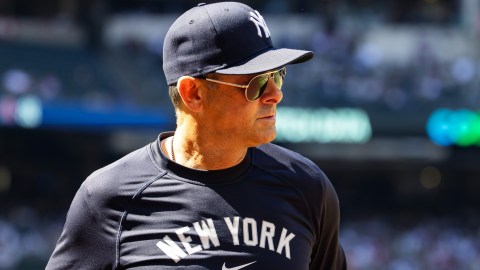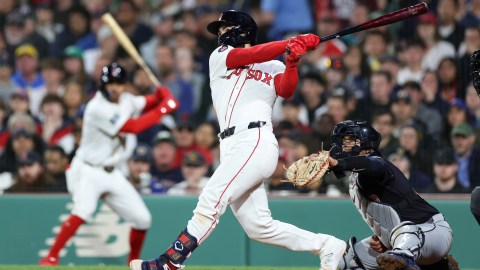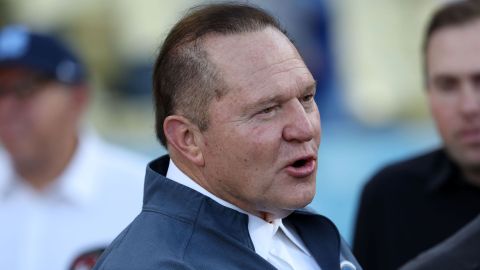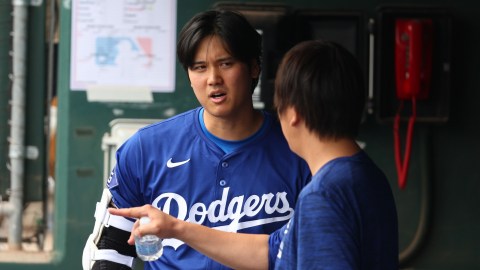Postseason baseball is terribly difficult to predict, but in hindsight, it shouldn’t come as a huge surprise that the Cleveland Indians and Chicago Cubs will square off in the World Series starting Tuesday.
Both teams took different paths to get to get here, but they do share one very important thing in common: Both clubs did a masterful job in team-building in order to have the chance to be four wins away from winning the World Series.
Here’s a closer look at how roster-building — on the field and off — helped these two teams get to where they are today.
CLEVELAND INDIANS
Success for both clubs starts at the top. Chris Antonetti, president of baseball operations, has been laying the groundwork in Cleveland for years. The Tribe hired him as an assistant in baseball operations all the way back in 1999 before allowing him to work his way up the system.
Originally serving under baseball lifer and architect of the Indians’ powerhouses of the 1990s, John Hart, Antonetti spent most of his Tribe apprenticeship under Mark Shapiro. Antonetti moved up the ranks, eventually taking over as general manager in 2010.
While there’s been no shortage of shrewd moves during Antonetti’s time in office, perhaps none were better than hiring Terry Francona as manager in 2013. Under Francona, a two-time World Series winner in Boston, the Indians have reached the playoffs twice and now play for a title of their own.
Antonetti and the Indians, however, don’t have unlimited funds like some of the big-market teams across baseball, and the Tribe entered the 2016 season with Major League Baseball’s seventh-smallest payroll.
That forced Antonetti to get creative, which he certainly did.
Here’s how Cleveland’s roster came to be.
POSITION PLAYERS
Catcher
Yan Gomes — The Indians acquired Gomes, along with Mike Aviles, in a 2012 trade for Esmil Rogers. In Cleveland, Gomes has evolved into a heart-and-soul player; Rogers is a middle-of-the-road reliever.
First baseman
Mike Napoli — Cleveland signed Napoli to a one-year, $7 million (remember those financial constraints) deal in the offseason. He hit 34 home runs and drove in 101 runs.
Second baseman
Jason Kipnis — Kipnis, an All-Star, was the Tribe’s second-round pick in 2009.
Shortstop
Francisco Lindor — Already one of the best shortstops in baseball, the Indians took the can’t-miss prospect with the No. 8 pick in the 2011 draft.
Third baseman
Jose Ramirez — The Indians signed Ramirez as an amateur free agent in 2009 and helped him develop into one of baseball’s most underrated players.
Left field
Rajai Davis — Cleveland signed Davis in the offseason. He’s one of the primary reasons Cleveland is one of MLB’s most aggressive teams on the basepaths.
Center field
Tyler Naquin — The Indians drafted Naquin with the No. 15 pick in the 2015 draft.
Right field
Lonnie Chisenhall — Chisenhall was the 29th pick in the 2008 draft.
PITCHERS
Starting pitchers
Corey Kluber — Kluber came to Cleveland from San Diego as part of a three-team trade that also included St. Louis. All the Tribe had to give up to get the future Cy Young winner was Jake Westbrook.
Josh Tomlin — The Indians drafted Tomlin in the 19th round of the 2006 draft, an obvious steal given the fact he’s already made 109 career starts.
Trevor Bauer — Cleveland acquired Bauer in a blockbuster three-team trade with Arizona and Cincinnati. In addition to getting the former No. 3 pick, the Tribe also acquired Bryan Shaw. The trade cost the Indians outfielder Shin-Soo Choo, but he was a pending free agent who ultimately signed a seven-year, $130 million contract with Texas.
Danny Salazar — The Indians signed Salazar as an amateur free agent in 2006, and he was an All-Star this season.
Carlos Carrasco — Cleveland acquired Carrasco in the famous Cliff Lee deal with Philadelphia in 2009. Carrasco, 29, has a 3.22 ERA in since the beginning of the 2014 season.
Relief pitchers
Dan Otero — The Tribe “purchased” Otero from Philadelphia in December, and he appeared in 62 games with a 1.53 ERA in 2016.
Bryan Shaw — Shaw also came to Cleveland in the Bauer blockbuster. He’s already pitched six innings in the playoffs.
Cody Allen — Cleveland drafted Allen in the 23rd round of the 2011 draft; he has 90 saves over the last three seasons.
Andrew Miller — The Indians made a big splash by acquiring Miller before the 2016 deadline, parting ways with a package of prospects, including Clint Frazier. It’s paid off, though, with Miller earning American League Championship Series MVP honors, and he’s still signed at just $9 million per season through 2018.
CHICAGO CUBS
Theo Epstein is no stranger to erasing a century of pain for a tortured fan base. The boy wonder ascended to general manager of the Boston Red Sox early in his career, winning two World Series and paving the way for a third before leaving in 2011.
He eventually landed in Chicago shortly thereafter, taking over a barren Cubs team that had just lost 91 games and would average 95 losses over Epstein’s first three seasons.
However, Epstein and his staff devoted themselves to replenishing the farm system, and the Cubs started to turn things around. Seemingly ready to take the next step, Chicago hired Joe Maddon prior to the 2011 season, a proven manager who had done a lot with little in Tampa Bay.
Now, just a little more than five years to the date of Epstein’s hiring, the Cubs are a baseball powerhouse, playing in their first World Series since 1945, looking to win their first title in 108 years.
POSITION PLAYERS
Catcher
Miguel Montero — Chicago acquired Montero in a trade with Arizona in December of 2014, giving up little of consequence. He’s one of the best young catchers in baseball.
First baseman
Anthony Rizzo — The Cubs acquired the perennial MVP candidate in a trade with San Diego, having to part with a minor leaguer and Andrew Cashner.
Second baseman
Javier Baez — They drafted Baez — one of baseball’s bright young stars — with the No. 9 pick in 2011.
Shortstop
Addison Russell — The Cubs gave up two pretty good starting pitchers for Russell in a trade with Oakland, but Russell is just entering his prime and figures to be a stalwart up the middle for years.
Third baseman
Kris Bryant — Chicago took Bryant with the No. 2 pick in 2013 draft and have already seen him develop into an elite power hitter (65 home runs in 306 career games).
Left field
Ben Zobrist — The Cubs made a nice free-agent splash by signing Zobrist in December.
Center field
Dexter Fowler — Fowler joined Chicago in a trade with Houston, as Chicago shipped Dan Straily and Luis Valbuena to the Astros for Fowler. He was a four-win player in 2016.
Right field
Jason Heyward — Largely a disappointment at the plate in 2016, the Cubs probably still have high hopes for Heyward after signing him to a massive contract away from the Cardinals. He’s still an elite defender.
PITCHERS
Starting pitchers
Jon Lester — The Cubs signed Lester to a massive contract in December of 2014, but he’s been worth every penny, solidifying himself as one of the best postseason pitchers of his (or perhaps any) generation.
Jake Arietta — The trade that brought Arrieta to Chicago might be one of the most lopsided in baseball history. The Cubs acquired the eventual Cy Young winner (and Pedro Strop) from Baltimore for Steve Clevenger and Scott Feldman in 2013.
Jason Hammel — Chicago traded Hammel to Oakland in the Russell deal, only to eventually re-sign him.
John Lackey — The Cubs signed Lackey, a proven October winner, to a two-year, $32 million deal after the 2015 season.
Kyle Hendricks — Hendricks led the National League in ERA in 2016 and pitched a gem in the pennant-clinching game after being acquired as a “minor leaguer” in the 2012 deadline trade that sent Ryan Dempster to Texas.
Relief pitchers
Travis Wood — The Cubs acquired Wood and two others in a December 2011 trade with Cincinnati. He’s an important left-handed arm in the Chicago pen.
Mike Montgomery — With the bullpen a looming question mark, Epstein bolstered his relief corps by acquring Montgomery in July.
Carl Edwards — The flame-throwing right-hander was a perceived afterthought in a 2013 trade sending Matt Garza to Texas.
Pedro Strop — Another important reliever, Strop was part of the Arrieta trade.
Hector Rondon — The Cubs picked up Rondon in the 2012 Rule 5 draft (from Cleveland), and he’s pitched 239 innings of relief over four seasons in Chicago.
Justin Grimm — Another solid bullpen arm who came to Chicago in the Garza trade.
Aroldis Chapman — Sometimes you’ve just gotta go for it, and the Cubs did just that in acquiring Chapman at the 2016 deadline for a package that included two top-100 prospects.
Thumbnail photo via Jerry Lai/USA TODAY Sports Images




